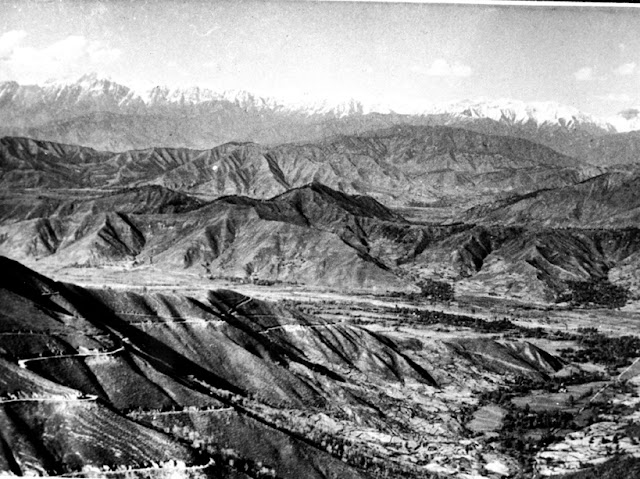The Sardar's Gambit – Destroying British Paramountcy : Two Telegrams, Two Visions, and the Kashmir Fault Line of 1946
In the charged summer of 1946,
as the grand edifice of the British Raj began to crumble, the future of India
was being forged not just in high-level conferences, but on the humble desks of
its leaders. On one such desk, belonging to Sardar Vallabhbhai Patel, landed
two telegrams. They were more than just messages; they were paper harbingers of
a storm, searing dispatches from the heart of Kashmir that exposed a
fundamental, seismic rift between the two primary architects of modern India:
the pragmatism of Patel and the ideological path of Jawaharlal Nehru.
The first crackle of the
telegraph machine on June 4th delivered a stark message from the Jammu Kashmir
Rajya Hindu Sabha. It was a direct and furious rebuttal to Nehru’s public
support for Sheikh Abdullah’s “Quit Kashmir” movement against Maharaja Hari Singh.
They accused Nehru of being swayed by “false one-sided propaganda” and deemed
his threat to lead protest groups into the state “wholly unwarranted.” This was
the first tremor—a clear signal that a significant community within Kashmir
felt betrayed not by their ruler, but by a titan of the Indian National
Congress.
Moments later, a second, more
desperate plea arrived. This was from the All State Kashmiri Pandit Conference,
their words seething with a sense of existential threat. They condemned Nehru’s
stance as “entirely unverified and tendentious,” accusing him of doing the
“greatest disservice” to the state by emboldening what they termed Sheikh
Abdullah's “fascist and communal programme.” Their anguish was palpable, vowing
to resist Abdullah’s agitation “to the last drop of our blood” and ending with
a simple, desperate appeal to the one man they believed could see the bigger
picture: “Kindly intervene.”
These telegrams laid bare a
perilous situation. Nehru, driven by a deep-seated ideological belief in
popular movements against monarchy, had thrown his weight behind Abdullah. For
him, the battle was a clear-cut struggle of the people against an autocratic
ruler. But for the Hindu minorities of Kashmir, this intervention was a
terrifying endorsement of a leader they feared, one that was dangerously
inflaming communal tensions.
Four days later, on June 8th,
the world witnessed Sardar Patel’s response. It was not a fiery retort but a
symphony of strategic genius, delivered with quiet authority to the All-India
States Peoples' Conference. Here, the profound difference between the two
leaders was cast in brilliant relief.
Where Nehru saw a single
battle in Kashmir, Patel saw a grand chessboard of 565 princely states. He
cautioned against “isolated direct actions,” arguing that the nation’s energy
must not be “frittered away in individual battles.” With the precision of a master
strategist, Patel identified the true adversary. The problem wasn't the
individual princes, he articulated, but the overarching force that empowered
them: “the British authority that backed those rulers.”
This was Patel’s masterstroke.
“There could be no deliverance for subjects in the states,” he declared,
“unless the paramountcy which protected the rulers was removed.” Why extinguish
hundreds of small fires, he reasoned, when you could cut off the source of the
inferno itself? His vision was to dismantle the entire structure of British
paramountcy first. Once that shield was gone, the princes would no longer be
British protectorates but would have to answer to the people of a free India,
in whom sovereignty would ultimately reside. He famously stated, “We are not to
make settlement with individual states, but with the entire princely order at
one time.”
This 1946 episode was more than a political disagreement; it was a clash of foundational philosophies. Nehru’s approach was one of passionate, immediate intervention based on principle. Patel’s was one of calculating, strategic patience aimed at a unified, systemic solution. As those two telegrams lay on his desk, the Sardar wasn't just reading words of protest; he was witnessing the formation of a political fault line in Kashmir, one that would vibrate with tremors of discord for decades to come, posing an enduring challenge to the very soul of India.
सरदार का दांव - ब्रिटिश सर्वोच्चता को नेस्तनाबूद करना : दो तार, दो नज़रिये और १९४६ की कश्मीरी दरार
४ जून को टेलीग्राफ
मशीन की पहली खनक ने जम्मू-कश्मीर राज्य हिंदू सभा का एक स्पष्ट संदेश पहुँचाया।
यह महाराजा हरि सिंह के खिलाफ़ शेख अब्दुल्ला के "कश्मीर छोड़ो" आंदोलन
को नेहरू के सार्वजनिक समर्थन का सीधा और उग्र खंडन था। उन्होंने नेहरू पर "झूठे
एकतरफा प्रचार" से प्रभावित होने का आरोप लगाया और राज्य में विरोध समूहों का
नेतृत्व करने की उनकी धमकी को "पूरी तरह से अनुचित" माना। यह पहला झटका
था—एक स्पष्ट संकेत कि कश्मीर के भीतर एक महत्वपूर्ण समुदाय अपने शासक से नहीं,
बल्कि
भारतीय राष्ट्रीय कांग्रेस के एक दिग्गज से विश्वासघात महसूस कर रहा था।
कुछ ही क्षणों बाद,
एक
दूसरी, और अधिक हताश अपील आई। यह ऑल स्टेट कश्मीरी पंडित कॉन्फ्रेंस की ओर से थी,
उनके
शब्द अस्तित्व के संकट की भावना से उबल रहे थे। उन्होंने नेहरू के रुख को
"पूरी तरह से असत्यापित और पक्षपातपूर्ण" बताकर उसकी निंदा की, और उन पर शेख
अब्दुल्ला के "फ़ासीवादी और सांप्रदायिक कार्यक्रम" को बढ़ावा देकर
राज्य का "सबसे बड़ा अहित" करने का आरोप लगाया। उनकी पीड़ा स्पष्ट थी,
उन्होंने
अब्दुल्ला के आंदोलन का "हमारे खून की आखिरी बूंद तक" विरोध करने की कसम
खाई और एक सरल, हताश अपील के साथ समाप्त किया, जो उस एक व्यक्ति से थी जिसके बारे में
उनका मानना था कि वह बड़ी तस्वीर देख सकता है: "कृपया हस्तक्षेप
करें।"
इन तारों ने एक
खतरनाक स्थिति को उजागर कर दिया। नेहरू, राजशाही के खिलाफ़ लोकप्रिय आंदोलनों में
एक गहरे वैचारिक विश्वास से प्रेरित होकर, अब्दुल्ला के पीछे खड़े हो गए थे। उनके
लिए, यह लड़ाई एक निरंकुश शासक के खिलाफ़ जनता का एक स्पष्ट संघर्ष था। लेकिन
कश्मीर के हिंदू अल्पसंख्यकों के लिए, यह हस्तक्षेप एक ऐसे नेता का भयावह समर्थन
था जिससे वे डरते थे, एक ऐसा नेता जो खतरनाक रूप से सांप्रदायिक तनाव को भड़का रहा था।
चार दिन बाद,
८
जून को, दुनिया ने सरदार पटेल की प्रतिक्रिया देखी। यह कोई आग उगलने वाला जवाब
नहीं था, बल्कि रणनीतिक प्रतिभा का एक अद्भुत प्रदर्शन था, जिसे अखिल भारतीय
राज्य जन-कांफ्रेंस में शांत अधिकार के साथ दिया गया। यहाँ, दोनों नेताओं के
बीच गहरा अंतर शानदार ढंग से स्पष्ट हो गया।
जहाँ नेहरू ने
कश्मीर में एक अकेली लड़ाई देखी, वहीं पटेल ने ५६५ रियासतों की एक भव्य
शतरंज की बिसात देखी। उन्होंने "अलग-थलग सीधी कार्रवाइयों" के खिलाफ़
आगाह किया, यह तर्क देते हुए कि राष्ट्र की ऊर्जा को "अलग-अलग लड़ाइयों में
बर्बाद नहीं किया जाना चाहिए।" एक माहिर रणनीतिकार की सटीकता के साथ, पटेल ने असली
दुश्मन की पहचान की। उन्होंने स्पष्ट किया कि समस्या अलग-अलग राजकुमार नहीं थे,
बल्कि
वह सर्वोच्च शक्ति थी जो उन्हें सशक्त बनाती थी: "ब्रिटिश सत्ता जो उन शासकों
का समर्थन करती थी।"
यह पटेल का
मास्टरस्ट्रोक था। उन्होंने घोषणा की, "राज्यों में प्रजा
को तब तक मुक्ति नहीं मिल सकती, जब तक कि शासकों की रक्षा करने वाली
सर्वोच्चता (Paramountcy) को हटा नहीं दिया जाता।" उन्होंने
तर्क दिया, सैकड़ों छोटी-छोटी आग बुझाने का क्या फ़ायदा, जब आप उस नरक के
स्रोत को ही काट सकते हैं? उनकी दृष्टि पहले ब्रिटिश सर्वोच्चता की
पूरी संरचना को ध्वस्त करने की थी। एक बार जब वह ढाल चली जाएगी, तो राजकुमार
ब्रिटिश संरक्षित नहीं रहेंगे, बल्कि उन्हें एक स्वतंत्र भारत के लोगों
के प्रति जवाबदेह होना होगा, जिनमें संप्रभुता अंततः निहित होगी।
उन्होंने प्रसिद्ध रूप से कहा था, "हमें अलग-अलग राज्यों के साथ समझौता नहीं
करना है, बल्कि एक ही बार में पूरे राजसी वर्ग के साथ करना है।"
१९४६ की यह घटना एक राजनीतिक असहमति से कहीं ज़्यादा थी; यह foundational दर्शनों का टकराव था। नेहरू का दृष्टिकोण सिद्धांत पर आधारित भावुक, तत्काल हस्तक्षेप का था। पटेल का दृष्टिकोण एक एकीकृत, प्रणालीगत समाधान के उद्देश्य से गणनात्मक, रणनीतिक धैर्य का था। जब वे दो तार उनकी मेज़ पर पड़े थे, तो सरदार सिर्फ़ विरोध के शब्द नहीं पढ़ रहे थे; वे कश्मीर में एक राजनीतिक दरार के निर्माण के गवाह बन रहे थे, एक ऐसी दरार जो दशकों तक असहमति के झटकों से कांपती रहेगी, और भारत की आत्मा के लिए एक स्थायी चुनौती पेश करेगी।
સરદારનો દાવપેચ - બ્રિટિશ સર્વોપરિતાને નાબૂદ કરવી : બે ટેલિગ્રામ, બે દ્રષ્ટિકોણ અને ૧૯૪૬ની કાશ્મીર તિરાડ
૧૯૪૬ના એ તંગ ઉનાળામાં, જ્યારે બ્રિટિશ રાજનો ભવ્ય કિલ્લો ધ્વસ્ત થઈ રહ્યો હતો, ત્યારે ભારતનું ભવિષ્ય માત્ર ઉચ્ચ-સ્તરીય પરિષદોમાં જ નહીં, પરંતુ તેના નેતાઓના ડેસ્ક પર પણ ઘડાઈ રહ્યું હતું. આવા જ એક ડેસ્ક પર, જે સરદાર વલ્લભભાઈ પટેલનું હતું, બે ટેલિગ્રામ આવી પહોંચ્યા. તે માત્ર સંદેશા ન હતા; તે એક તોફાનના કાગળ પર લખાયેલા અગ્રદૂત હતા, કાશ્મીરના હૃદયમાંથી આવેલા એ તીક્ષ્ણ સંદેશા જેમણે આધુનિક ભારતના બે મુખ્ય શિલ્પકારો વચ્ચેના મૂળભૂત, વિનાશક વિભાજનને ઉજાગર કર્યું: પટેલનો વાસ્તવવાદ અને જવાહરલાલ નેહરુનો વૈચારિક માર્ગ.
૪ જૂનના રોજ ટેલિગ્રાફ મશીનમાંથી આવેલા પ્રથમ સંદેશાએ જમ્મુ અને કાશ્મીર રાજ્ય હિન્દુ સભા તરફથી એક સ્પષ્ટ સંદેશ આપ્યો. તે મહારાજા હરિ સિંહ વિરુદ્ધ શેખ અબ્દુલ્લાના "કાશ્મીર છોડો" આંદોલનને નેહરુના જાહેરસમર્થનનો સીધો અને ઉગ્ર વિરોધ હતો. તેમણે નેહરુ પર "ખોટા એકપક્ષીય પ્રચાર"થી પ્રભાવિત હોવાનો આરોપ મૂક્યો અને રાજ્યમાં વિરોધ જૂથોનું નેતૃત્વ કરવાની તેમની ધમકીને "સંપૂર્ણપણે અયોગ્ય" ગણાવી. આ પ્રથમ આંચકો હતો—એક સ્પષ્ટ સંકેત કે કાશ્મીરનો એક મહત્વપૂર્ણ સમુદાય તેમના શાસકથી નહીં, પરંતુ ભારતીય રાષ્ટ્રીય કોંગ્રેસના એક દિગ્ગજ નેતાથી દગો અનુભવી રહ્યો હતો.
થોડી જ વારમાં, બીજી, વધુ હતાશાભરી વિનંતી આવી. આ ઓલ સ્ટેટ કાશ્મીરી પંડિત કોન્ફરન્સ તરફથી હતી, તેમના શબ્દો અસ્તિત્વના સંકટની ભાવનાથી ઉકળી રહ્યા હતા. તેમણે નેહરુના વલણને "સંપૂર્ણપણે ચકાસ્યા વિનાનું અને પક્ષપાતી" ગણાવીને વખોડી કાઢ્યું, અને તેમના પર શેખ અબ્દુલ્લાના "ફાસીવાદી અને સાંપ્રદાયિક કાર્યક્રમ"ને પ્રોત્સાહન આપીને રાજ્યનું "સૌથી મોટું અહિત" કરવાનો આરોપ મૂક્યો. તેમની વેદના સ્પષ્ટ હતી, તેમણે અબ્દુલ્લાના આંદોલનનો "અમારા લોહીના છેલ્લા ટીપા સુધી" વિરોધ કરવાની પ્રતિજ્ઞા લીધી અને એક સરળ, હતાશ અપીલ સાથે પત્ર પૂરો કર્યો, જે એવા એકમાત્ર વ્યક્તિને સંબોધીને હતી જેમના પર તેમને વિશ્વાસ હતો કે તેઓ પરિસ્થિતિને વ્યાપક દ્રષ્ટિએ જોઈ શકે છે: "કૃપા કરીને હસ્તક્ષેપ કરો."
આ ટેલિગ્રામોએ એક ભયંકર પરિસ્થિતિને ઉજાગર કરી. નેહરુ, રાજાશાહી વિરુદ્ધના લોકપ્રિય આંદોલનોમાં ઊંડા વૈચારિક વિશ્વાસથી પ્રેરાઈને, અબ્દુલ્લાની પાછળ ઊભા રહ્યા હતા. તેમના માટે, આ લડાઈ એક નિરંકુશ શાસક સામે લોકોનો સ્પષ્ટ સંઘર્ષ હતો. પરંતુ કાશ્મીરના હિન્દુ લઘુમતીઓ માટે, આ હસ્તક્ષેપ એક એવા નેતાનું ભયાવહ સમર્થન હતું જેનાથી તેઓ ડરતા હતા, એક એવો નેતા જે ખતરનાક રીતે સાંપ્રદાયિક તણાવ ભડકાવી રહ્યો હતો.
ચાર દિવસ પછી, ૮ જૂનના રોજ, દુનિયાએ સરદાર પટેલની પ્રતિક્રિયા જોઈ. તે કોઈ આક્રોશભર્યો જવાબ નહોતો, પરંતુ વ્યૂહાત્મક પ્રતિભાનું એક અદ્ભુત પ્રદર્શન હતું, જે અખિલ ભારતીય રાજ્ય જન-પરિષદમાં શાંત અધિકાર સાથે રજૂ કરવામાં આવ્યું હતું. અહીં, બંને નેતાઓ વચ્ચેનો ગહન તફાવત સ્પષ્ટપણે ઉભરી આવ્યો.
જ્યાં નેહરુએ કાશ્મીરમાં એકમાત્ર યુદ્ધ જોયું, ત્યાં પટેલે ૫૬૫ રજવાડાંઓની એક ભવ્ય શતરંજની બાજી જોઈ. તેમણે "અલગ-અલગ સીધા પગલાં" સામે ચેતવણી આપી, દલીલ કરી કે રાષ્ટ્રની ઊર્જા "વ્યક્તિગત લડાઈઓમાં વેડફવી ન જોઈએ." એક કુશળ વ્યૂહરચનાકારની ચોકસાઈ સાથે, પટેલે સાચા શત્રુને ઓળખી કાઢ્યો. તેમણે સ્પષ્ટ કર્યું કે સમસ્યા વ્યક્તિગત રાજાઓ નહોતા, પરંતુ તેમને સશક્ત બનાવનારી સર્વોચ્ચ શક્તિ હતી: "બ્રિટિશ સત્તા જે તે શાસકોને ટેકો આપતી હતી."
આ પટેલનો માસ્ટરસ્ટ્રોક હતો. તેમણે જાહેર કર્યું, "રાજ્યોમાં પ્રજાને ત્યાં સુધી મુક્તિ મળી શકે નહીં, જ્યાં સુધી શાસકોની રક્ષા કરતી સર્વોપરિતા (Paramountcy)
દૂર કરવામાં ન આવે." તેમણે તર્ક આપ્યો કે, સેંકડો નાની આગ ઓલવવાનો શું ફાયદો, જ્યારે તમે આગના મૂળ સ્ત્રોતને જ કાપી શકો છો? તેમની દ્રષ્ટિ પહેલા બ્રિટિશ સર્વોપરિતાની સંપૂર્ણ રચનાને તોડી પાડવાની હતી. એકવાર તે ઢાલ દૂર થઈ જાય, પછી રાજાઓ બ્રિટિશ સંરક્ષિત નહીં રહે, પરંતુ તેમને એક સ્વતંત્ર ભારતના લોકો સમક્ષ જવાબદાર બનવું પડશે, જેમાં સાર્વભૌમત્વ આખરે નિહિત થશે. તેમણે પ્રખ્યાત રીતે કહ્યું હતું, "આપણે અલગ-અલગ રાજ્યો સાથે સમાધાન નથી કરવાનું, પરંતુ એક જ સમયે સમગ્ર રાજવી વર્ગ સાથે સમાધાન કરવાનું છે."
૧૯૪૬ની આ ઘટના માત્ર રાજકીય મતભેદ કરતાં વધુ હતી; તે પાયાના દર્શનશાસ્ત્રોનો સંઘર્ષ હતો. નેહરુનો અભિગમ સિદ્ધાંત પર આધારિત જુસ્સાદાર, તાત્કાલિક હસ્તક્ષેપનો હતો. પટેલનો અભિગમ એકીકૃત, પ્રણાલીગત ઉકેલના હેતુથી ગણતરીપૂર્વક, વ્યૂહાત્મક ધીરજનો હતો. જ્યારે તે બે ટેલિગ્રામ તેમના ડેસ્ક પર પડ્યા હતા, ત્યારે સરદાર માત્ર વિરોધના શબ્દો જ નહોતા વાંચી રહ્યા; તેઓ કાશ્મીરમાં એક રાજકીય તિરાડના નિર્માણના સાક્ષી બની રહ્યા હતા, એક એવી તિરાડ જે દાયકાઓ સુધી અસંમતિના આંચકાઓથી કંપતી રહેશે અને ભારતના આત્મા માટે એક કાયમી પડકાર ઊભો કરશે.


















